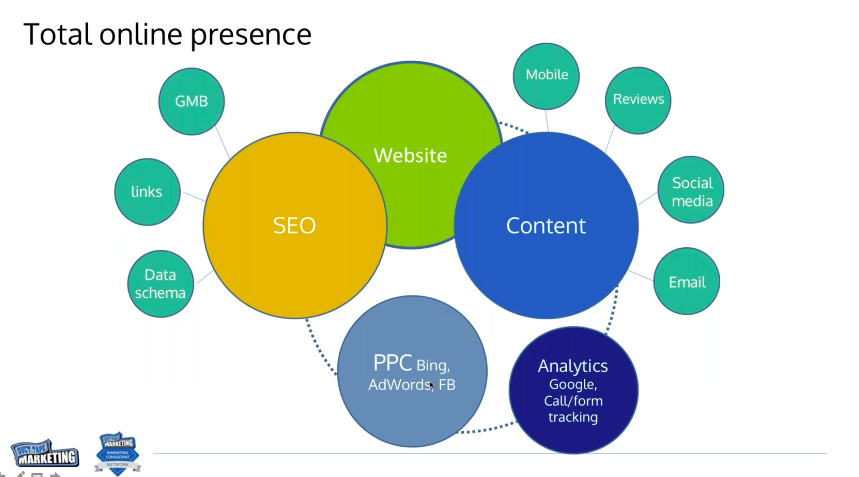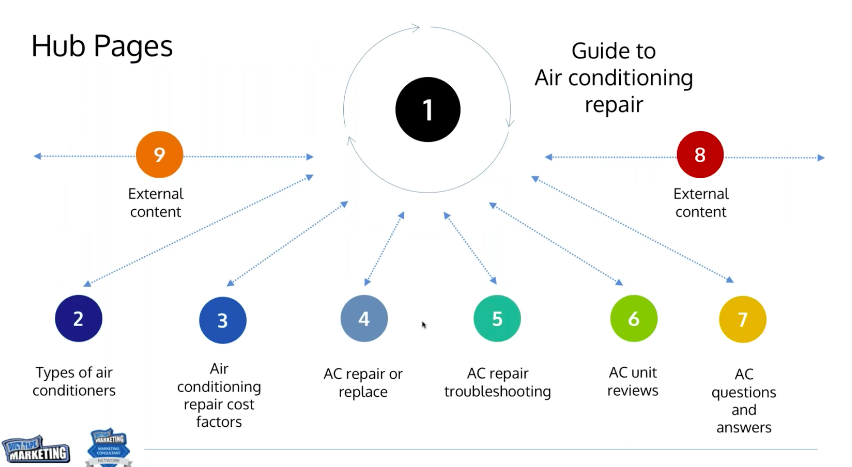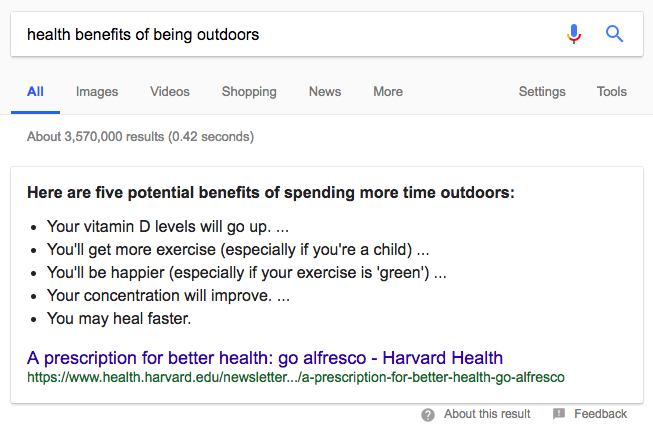5 Steps to Small Business Search Engine Optimization written by John Jantsch read more at Duct Tape Marketing
The video above is a replay of a recent live webinar I conducted. Combined with the text below you should have a pretty good feel for the steps necessary for small business SEO.
If you’re looking for a highly technical post on search engine optimization (SEO), this is not the content for you, and honestly, that’s because I don’t believe SEO is that technical (unless you have an e-commerce site, in which case it can be). There are elements you have to understand, but you mainly have to apply the right tactics on a consistent basis.
So, without further ado, here are the five steps that I would recommend for small businesses as they dive into their SEO efforts.
1. Strategy First
Back in the day, people would get a website built, they’d get somebody to put content in the website, and then they’d find somebody to “SEO the site,” but you can’t approach SEO that way today because every aspect of your total online presence is so highly integrated (see image below), that you really have to think about all of the components at the same time.

This is why I put such a strong emphasis on focusing on strategy first.
When focusing on your strategy, start by developing a list of problems that your target audience is experiencing that you can help them solve. Conduct keyword research around this list of core themes and identify the top five or so topics that you’ll produce content around. So, instead of writing about your products and services, you’ll write about, in detail, the problems your audience is facing and how to fix them.
Content is such a big part of SEO these days. You must create content that your audience will want to read and find useful, which allows you to make a connection to the solutions that you sell. That’s how you think strategically about search engine optimization.
The key is to hone in on four or five core topics and start producing content around those. Your website structure and content need to revolve around these few themes which will make your content development easier and more focused.
To develop these themes, I brainstorm a bunch of topics, and then there are a few tools I use to narrow them down:
This is a free tool from Google that is a part of Google Ads and is often used by advertisers to figure out what search terms and keywords they should bid on, but it’s also a great tool for giving you data on what search terms are being searched for.
In addition to monthly search volume and competition, Google Keyword Planner also gives you a suggested bid for the term, and while you aren’t using this for advertising purposes per se, it can help you see which word may generate more conversions or sales because people are willing to pay more for it in their advertising, which is a good clue it could be a good word for you to target with your content. Decent volume and a higher suggested bid could be good indicators that those are good themes you should go after.
This tool gives you questions that people are asking which often show high intent (questions are great for voice search SEO as well).
When you type in a search term, this site will give you a bunch of variations and questions people are asking related to that term.
Google Auto-Complete
If you just start typing a keyword into the search box on Google, it will start to suggest what terms they think you’re after or related common searches (there are also related searches at the bottom of the search page). These related terms are often ones that have high volume.

Keywords Everywhere (Chrome Extension)
When you type in a search term in Google, this extension will provide a sidebar on the right side of search engine results pages that shows you related keywords and other things that people have been searching for, as well as volume and cost per click.
Once you have the handful of themes that you’d like to move forward with, I’d recommend creating what I call hub pages that have a lot of related links driving back to them, including block posts related content that you produce over a year or so. From a structural standpoint, I’d make these hub pages prominent tabs on your main site navigation (more on the hub content later).
2. Google My Business
Once your strategy is in place, you have to essentially bow down to Google, especially if you’re a local business. For local businesses, Google My Business has become one of your most important search engine optimization assets.
Google My Business is also how you get into Google Maps that show up above the organic listings. To determine who shows up in this 3-pack, Google factors in the proximity of where you currently are, but it also factors in if your Google My Business listing is properly optimized. To optimize your listing:
- Make sure it’s claimed
- Make sure there aren’t any duplicates of the listing
- Add a specific and relevant category
- Include your company’s name, address, local phone number, and website (these should match the information on your website)
- Add photos and videos
- Add positive reviews (these are a huge ranking factor on their own) – Be sure to respond to all reviews, both positive and negative.
- Publish Google Posts
To be effective with your SEO, small businesses need to not only take advantage of Google My Business, but the entire Google Universe as well, including Google My Business, Google Analytics, Google Search Console, and Google Ads, because they all integrate together to help you get the results you desire.
3. On-site ranking factors
If you’re trying to optimize a page for a keyword phrase, you get to set the:
- URL of the page
- Page title (meta)
- Header tags – H1 and H2
- Alt image attribute
- Page content
Take a look at these elements on the page you’re reading now – you’ll see SEO tips and strategies for small business in a number of places because that’s what this page is optimized for.
So, include the keyword in those areas! Now, this is not to say you should keyword stuff because you shouldn’t. You still want to write for humans, but be sure to take the opportunity to get your most important keywords in these areas. The page title, meta description, and URL also influence the snippet that shows up in search engine results pages (meta description isn’t an actual ranking factor, but it is a click-through factor, kind of like an ad for somebody to click).
I use the Yoast SEO plugin for WordPress, which is a free plugin that helps me optimize this metadata. I highly recommend using it!
To supplement these on page efforts, you must control your Google Search Console as well. This is where you tell Google what’s on your website. To do this effectively:
- Claim and verify your profile
- Add your sitemap
- Check your messages
- Integrate it with Google Analytics
4. Content Hubs
I spoke about this briefly earlier in the post but thought I’d dive a little deeper. Content is no longer just a tactic; it’s like the air that’s necessary for your marketing efforts, which is why these hubs are so important because this content becomes such an important asset over time.
If you were working with an HVAC contractor, for example, this is what a hub page (Guide to Air Conditioning Repair) with its various sections may look like:

On these pages, you’d include links to all of the content you’re writing about these topics as well curated content from other websites that are related, creating a link building structure that shows Google all of this content is related. It essentially shows Google that you have useful content for your audience. Remember, the guide itself will be in your main site navigation.
If you create 4-5 hub pages over the course of the year and just keep building upon them, they will be huge assets for your business.
Here’ an example of a hub page we’ve put together for Duct Tape Marketing: The Ultimate Guide to Local Marketing.
5. Off-site ranking factors
These are things that you do have some control over, but they’re not on your website (although typically point back to your site). These are other factors that tell Google what your site’s about, what people think about it, that it’s important, etc.
Clean data
Make sure all listing and directories are accurate across the web. This is especially important if your business has moved. Your data needs to be consistent. There are a few tools that can help to ensure your data is clean including Yext and MozLocal (both offer free scans to see where you stand and can help you fix them).
Links from other sites
If people link to posts on your site (a backlink), this tells Google that people think you have great content on your site. It acts as a popularity vote. Good places to look to add links to your site include:
- Alumni sites
- Strategic partners and suppliers
- Local events
- Media
- Chamber of Commerce
Reviews
When people write about your business and type in what a business does well, Google recognizes this. The following are areas to add reviews:
- Yelp
- Industry-related review sites
Social signals
When people talk about you on social media, Google pays attention to those mentions.
Domain authority
You have less to do with this, but it’s a huge ranking factor. This factors in how many links back to your site are from important sites, how long the domain has been around, and so on.
To recap the information above, you must have a plan; you must take advantage of the Googleverse, you must optimize and pay attention to on and off page ranking factors, and you need to build content hubs.
Need more tips on search engine optimization? Check out our entire Guide to Small Business SEO.
